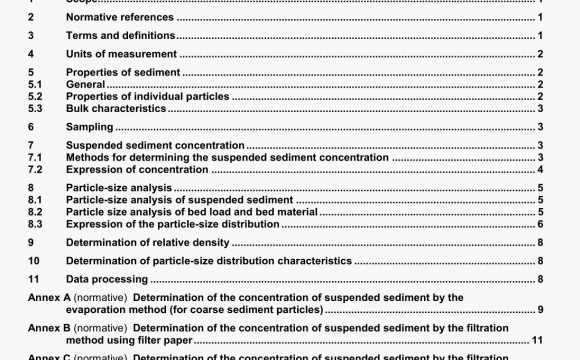ISO 4365 pdf download – Liquid flow in open channels一Sediment in streams and canals – – Determination of concentration, particle size distribution and relative density.
8 Particle-size analysis
8.1 Particle-size analysis of suspended sediment
For particle-size analysis, suspended sediment may be classified in terms of the diameter of the suspended
solids as follows:
a) coarse sediment containing particles with a diameter greater than 0.25 mm:
b) medium sediment containing particles with a diameter of 0,062 mm to 0,25 mm:
c) fine sediment: containing particles with a diameter less than 0.062 mm.
The methods for analysing suspended sediment of these classes are specified in Annex D.
NOTE In the case of suspended sediment, grading by particle size of the <0.062mm fraction is usually not carried out because of the unimportance of accurately separating the nIl amount of solid perticles that generaly exist in suspension. It, however, a more precse separation between the coerse and medium sediments Is required, the procedure specified In 8.2 for bed-load and bed matenal can be used. A particle-size analysis procedure for tIne sediment Is given in
E.3.5.
8.2 Particle-size analysis of bed-load and bed material
For the analysis of the bed-load or bed material for particle size distribution and mean diameter of samples. they are classified broadly into those of diameter greater than, and those of diameter less than, 0.5 mm. Classification of material into these two ranges is suitable for the computation of bed-load
The methods for analysing bed-load and bed material are specified in Annex E
The particle-size distribution of sediment may be determined by sieving (when particles are all coarse), by a con, bination & sieving and settling velocity, or indirectly by measuring particle-settIng velocities in a column of liquid. It would be advantageous to use only one measure of diameter over the entire range of sizes for all sediments, preferably the sedimentation diameter, but this is not practicable, slice large particles will settle very rapidly in the sedimentation liquid This causes difficulties in dispersion, and would thus require larger equipment. On the other hand, sieve dimensions and the quantity of material avadable will set a limitation on the size of fine particles. Therefore, in practice, the coarser particles of suspended sechment (diameter greater than 0.25 mm) and the coarser particles of bed-load and bed material (diameter greater than 0,5 mm) are analysed by sieving and all the finer material by sedimentation techniques. This may result in a small abrupt break in the particle size dlstnbutlon curve, which may be adjusted by the use of the approximate relationship among the diameters, as given In Equation (1):
Frequency-stnbutlon tables should be prepared from sÉze analyses to present the data Ei an orderly form
In order to draw up the frequency distribution, the total range of sizes (diameters in millimetres) is divided into intervals, called “class intervals”, the number of wt,icti will depend on the classes into which the sample has been divided. The percentage of the total mass of the sample falling within each one of these intervals is tabulated Thus, if an Interval has limits of 010mm and 0,08 mm, the percentage of the total mass of the sample falling witNn this size range is tabulated and called the frequency of that particular class interval.
For the size distribution of coarser material, particularly for bed-load or bed material, the distnt,ution is obtained with unequal class intervals; but tot the size distflbution of suspended material, a class interval of 0,02 mm is adopted over the range 0,062 mm to 0,50 mm. Particles larger than 0,50 mm and smaller than 0,062 mm are broadly classified as class 0,50mm” and class <0,062 mm”. respectively.
8.3.2 Graphical presentation
8.3.2.1 The data from a parlcle-size analysis may be presented In three different graphical forms
a) as histograms;
b) as frequency polygons and frequency cwves:
C) as cumulative curves or particle-size summation curves.
The simplest manner of depicting the results 01 a mechanical analysis is to prepare a histogram of the data. The diameter, expressed in millimetres, Is usually chosen as the independent variable, with the frequency as the dependent variable. In general, the class Intervals are the abscissa, and above each class, a vertical rectangle of width equal to the class interval and height proportional to the frequency In the class, is drawn (see Figure 1).
ISO 4365 pdf download – Liquid flow in open channels一Sediment in streams and canals – – Determination of concentration, particle size distribution and relative density
